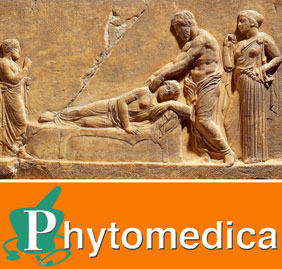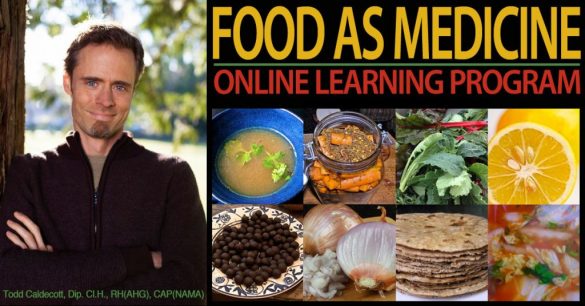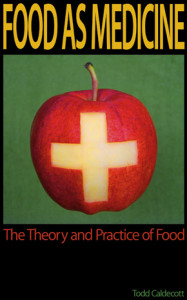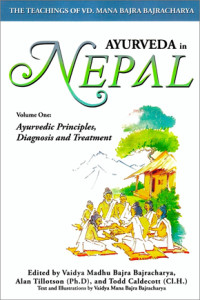Some of you who follow my Facebook page may have seen updates about the birth of five puppies to my female dog, Sophie, in late April. For those who haven’t, I’ve compiled an online photo album that documents their growth and development over the past few months.
If I had to choose one word to describe the whole process of being surrogate grandparents to these pups, it would be epic. Every day since their birth has been filled with interest, excitement, and wonder.
From a neurochemical perspective, snuggling with puppies has done a lot to raise the collective oxytocin levels in our home. Over the summer, our front garden—with its jumble of humans and puppies lying together in the grass—often resembled something like an opium den, attracting a steady stream of “customers” from far and wide.
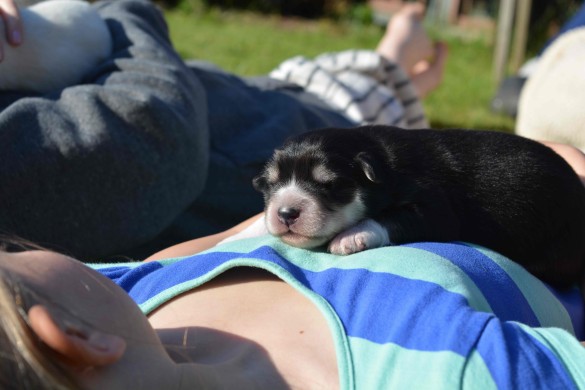
Of course, this bliss was sometimes interrupted. I underestimated their collective destructive power. Up until about six weeks old, the fencing I had around my backyard pots, garden boxes, kitchen herbs, raspberries, and squashes seemed to work well. I admit, I was a little smug in my satisfaction.
Then, like a reckoning, those “adorable” puppies tore it all apart in no time. For weeks, it became a ritual to wake up, look out the bedroom window, and see five wagging pups proudly showing me how “busy” they’d been overnight. No matter how many times I repaired or reinforced the fencing, they would bust through, rip it apart, or simply chew it into tiny pieces.
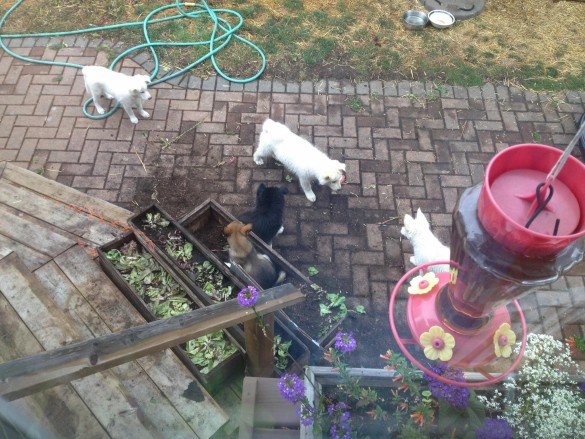
Beyond the wanton destruction of everything green—or anything fibrous, including corners of the house and welcome mats—my main concern these past few months was the proper nourishment of Sophie and the puppies. During pregnancy, I supplemented Sophie’s diet with organ meats such as liver and heart, along with her usual raw, meaty, cartilaginous bones.
At three years old, her body was mature enough for puppies, but as the smallest of her litter, I knew weight maintenance would be a challenge. Early in her pregnancy she went off her food, which was a little nerve-wracking but a normal response. By mid-to-late pregnancy, however, she was eating huge amounts.
Sophie went into labor about a week early. Since she hadn’t done much nesting, she ended up giving birth on my daughter’s bed late one night. After my daughter called out, I staggered in half-asleep to see the first puppy already born, with another on the way. Instinct kicked in quickly—before the second pup was even out, Sophie had ripped open the amniotic sac, eaten it along with the placenta, and licked the pup clean.
There is debate about whether humans should eat the afterbirth, given we’re the only mammal that doesn’t. All I’ll say is that if it were consumed in the same manner as other mammals, I can’t see how it would hurt—though I know the thought is off-putting for many. Cooking, freeze-drying, or encapsulating the placenta is offered as an alternative, but I’m not aware of research showing it’s necessary. What is required postpartum is extra nutrition and support, which can also be provided through a building (brimhana) diet in Ayurveda, along with rejuvenating herbs. A nutrient-rich diet and a supportive environment are excellent ways to help avoid postpartum depression and ensure recovery.
Given Sophie’s more asthenic nature, by four weeks of lactation she was looking a little skinny—though not dangerously so. It was time to start introducing food to the puppies. Those who have read my blog know I don’t put much stock in the dry food diet promoted by most vets and the pet food industry. Still, I knew that puppies have distinct nutritional needs, so I researched how to provide this through the same natural raw food diet I’ve been feeding my animals for 15 years.
What I found online was a bizarre potpourri of “expert” suggestions, including cereals, legumes, and nuts—foods that have no place in a dog’s diet. As members of the Canidae family, dogs require mostly meat and bone, though they can digest some carbohydrates and naturally seek out fibrous plants like grass as a digestive aid. Some breeds, such as huskies, have very limited tolerance for starches, which should be avoided.
The best diet for weaned puppies is therefore meat-based. Ground lamb, turkey, or beef can serve as a good base. To ease the transition, fermented raw milk such as buttermilk or yogurt is excellent as a first food.
Solid food cannot be only muscle meat. Nutrient-dense organ meats (offal such as heart, gizzards, liver, kidney) are essential. While teeth are still developing, these can be blended with ground meat, making up no more than 20% of the total recipe. Liver should be added only once or twice a week, since excessive vitamin A can cause problems like weight loss, emaciation, joint pain, impaired growth, and a rough coat.
Raw egg yolks—carefully separated from the whites—are another excellent addition. Egg whites should be avoided due to avidin, which interferes with biotin absorption.
Additional minerals and fatty acids are also essential. While adult dogs can chew soft bones and cartilage, four-week-old puppies cannot, so another “boney” source is needed. Some commercial sources sell ground raw bone, but I’ve avoided them. I can’t see what goes into the grinder, and my dogs have never liked it.
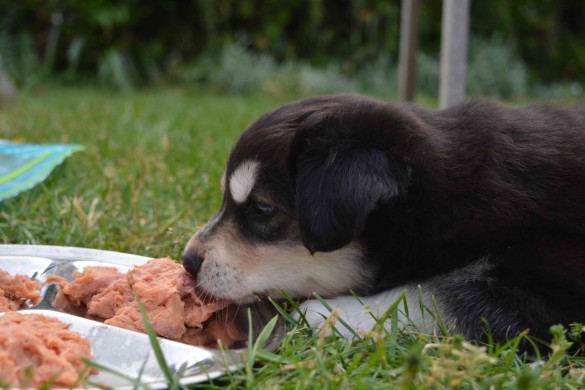
Instead, I turned to an old folk remedy for weak bones that has attracted recent scientific interest: egg shells. Mostly calcium but also rich in trace minerals in a ratio similar to bone, egg shells are a cheap and effective way to boost mineral content—for dogs and humans alike. Unlike commercial calcium carbonate or oyster shell, egg shells are low in toxic minerals such as aluminum and heavy metals. A half-teaspoon provides almost a gram of calcium, along with strontium, magnesium, boron, zinc, phosphorus, selenium, and more (details here).
Since we were already using egg yolks in the puppies’ food, we had plenty of shells. If you want to use them, start saving during pregnancy. To prepare: rinse after cracking, set aside to dry, and when you have a tray full, sterilize by baking at 225˚C for 30–60 minutes (before browning) or by boiling for 2–3 minutes. Once cooled, grind to a fine powder in a coffee grinder, sieve through a fine mesh, and regrind or discard any large particles. Store in a clean, dry container and mix into food as needed. I also added kelp, one of the richest plant sources of minerals, as a further safeguard for balance.
Finally, I considered the role of fat in the puppies’ diet. When I first got Sophie, she was clearly the runt—skinny with a dull coat, no doubt from cheap puppy kibble. While she adapted to raw food, she wasn’t gaining fast enough. I began hand-feeding her grass-fed butter, which she devoured.
Grass-fed butter, often overlooked, has a balanced ratio of omega-6 and omega-3 fatty acids, both essential for dogs and humans. Within weeks of this “butterfest,” Sophie’s coat became soft and glistening—and has stayed that way ever since.
With that in mind, I added butter to the puppies’ food, rotating in olive oil, coconut oil, and home-rendered lard. The recipe I devised was:
- 1 cup raw (previously frozen) ground beef, lamb, turkey, or pork
- includes 20% ground offal (heart, liver, kidney, gizzard, etc.)
- avoid using only liver to prevent vitamin A toxicity
- 2 raw egg yolks (no whites)
- 4 tbsp egg shell powder
- 2–3 tbsp melted grass-fed butter, lard, or tallow
- olive oil and coconut oil can be rotated in
- 1–2 tsp kelp powder
While this recipe made up most of the diet during and after weaning, we added other foods as they grew. One of the first was frozen smelts—tiny whole fish with heads, guts, and eggs. At first the pups weren’t sure what to do, but once they figured it out, they gobbled them with abandon. I also used canned (bone-in) sardines to boost Sophie’s calcium when she was lactating but disinterested in her usual meals.

By the eighth week, the puppies were ready for whole foods. I laid out small pieces of raw, meaty bone like Sophie eats, and let the pups investigate. They approached cautiously, then backed away, as if the meat might attack them. But soon they sniffed, licked, and finally tore into it.
Within a day they had figured it out, and mealtime became a raucous food fight—stealing, chasing, tug-of-war battles, and eventually everyone getting a share. With only the two female pups now left in our care, at four and a half months they essentially eat the same diet as their mother, growing quickly into two beautiful young dogs.
If you have a new puppy and are unsure what to feed, I hope this post has been useful. Feel free to post questions in the comments below. Please note: I am not a veterinarian and cannot advise on feeding sick or unwell puppies. Any information from this blog you choose to apply is at your own risk.


